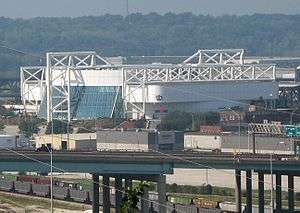1976 Republican National Convention
The 1976 Republican National Convention was a United States political convention of the Republican Party that met from August 16 to August 19, 1976, to select the party's nominee for President. Held in Kemper Arena in Kansas City, Missouri, the convention nominated President Gerald Ford for a full term, but only after narrowly defeating a strong challenge from former California Governor Ronald Reagan. The convention also nominated Senator Bob Dole of Kansas for vice president, instead of Vice President Nelson Rockefeller, who did not seek nomination for a full term. The keynote address was delivered by Tennessee Senator Howard Baker. Other notable speakers included Minnesota Representative Al Quie, retired Lieutenant Colonel and former Vietnam prisoner of war Raymond Schrump, former Texas Governor John Connally, Providence, Rhode Island mayor Vincent Cianci and Michigan Senator Robert P. Griffin. It is the last national convention by either of the two major parties to feature a seriously contested nomination between candidates.
1976 presidential election | |
  Nominees Ford and Dole | |
| Convention | |
|---|---|
| Date(s) | August 16–19, 1976 |
| City | Kansas City, Missouri |
| Venue | Kemper Arena |
| Candidates | |
| Presidential nominee | Gerald Ford of Michigan |
| Vice presidential nominee | Bob Dole of Kansas |

History
Kansas City had not hosted a major party convention since the 1928 Republican National Convention that nominated Herbert Hoover.[1] Its premier venue, Kemper Arena, was diminutive by national standards but it was new, and the city aggressively courted the convention planners of both parties.[1] The Democrats demurred early on, citing a lack of hotel accommodations, but Republicans were more receptive because the city had a reliably enthusiastic base of the party, and "fit the Midwestern image of Jerry Ford".[1]

Situation at the opening of the convention
Going into the convention, Ford had won more primary delegates than Reagan, as well as a plurality in popular vote. However, Ford did not have enough delegates to secure the nomination (1,130 delegates were needed to win the presidential nomination), and as the convention opened both candidates were seen as still having a chance to win. Because of this, both Ford and Reagan arrived in Kansas City before the convention opened to woo the remaining uncommitted delegates in an effort to secure the nomination.
Reagan benefited from his highly committed delegates, notably "Reagan's Raiders" of the Texas delegation. They and other conservative Western and Southern delegates particularly faulted the Ford Administration's foreign policy of détente towards the Soviet Union, criticizing his signing of the Helsinki Accords and indirectly blaming him for the April 1975 Fall of Saigon.
The pro-Reagan Texas delegates worked hard to persuade delegates from other states to support Reagan.
Ford, meanwhile, used all of the perks and patronage of the presidency to win over wavering delegates, including trips aboard Air Force One and personal meetings with Ford himself. White House Chief of Staff Dick Cheney proved to be an important figure in working to build support among those state delegations on the fence between Ford and Reagan, including the Mississippi delegation. White House political advisor Harry Dent also played a central role in helping President Ford work with the state delegations, who met with Ford and his aides in a Presidential office set up on-site at the convention in Kansas City.
Headlines during the Republican convention in Kansas City hinted at the still-simmering debates within the rank-and-file of the Republicans as to whether or not a new party might be formed out of the weaknesses of the Republicans. "Conservatives Seek a New Party if Reagan Loses," The Chicago Tribune's Wednesday, August 18, 1976 headlines told readers during the Kansas City convention, which quoted both White House aides as well as critics in the Republican Party who debated the possibility of a new party emerging out of that year's division in the Republican ranks.
Newspaper headlines also told the story of the uncommitted delegates whose "wavering" at the convention made them the focus of both the Ford and the Reagan camps. "New 'Stars' Stealing GOP Show," The Chicago Tribune's Wednesday, August 18, 1976 headlines told readers. Estimates ranged from 93 to as many as 115 delegates uncommitted at the time of the convention. The largest block of uncommitted delegates were from Mississippi and another block were from Illinois' delegation.
Wednesday, August 18, 1976 saw the uncommitted delegates break on the 1st ballot for President Gerald Ford, who won the nomination on the 1st roll call of delegates by a vote of 1,187-1,070.
Richard Schweiker gambit and the search for an alternative
Reagan had promised, if nominated, to name Senator Richard Schweiker of Pennsylvania as his running mate, in a bid to attract liberals and centrists in the party. This move backfired, however, as many conservatives (such as Senator Jesse Helms) were infuriated by Reagan's choice of the "liberal" Schweiker, while few moderate delegates switched to Reagan. Helms promptly began a movement to draft Conservative Senator James L. Buckley of New York as the presidential nominee.
Platform and rules votes
The key vote of the convention occurred when Reagan's managers proposed a rules change that would have required Ford to publicly announce his running mate before the presidential balloting. Reagan's managers hoped that when Ford announced his choice for vice president, it would anger one of the two factions of the party and thus help Reagan. Ford's supporters derisively described the proposed rules change as the "misery loves company" amendment.[2] The proposed rules change was defeated by a vote of 1180 to 1069, and Ford gained the momentum he needed to win the presidential nomination. The balloting was still close, however, as Ford won with 1187 votes to 1070 votes for Reagan (and one for Elliot L. Richardson of Massachusetts).
Conservatives succeeded in inserting several key planks into the party platform, some of which were implicitly critical of the President's own policies.[3] Reagan and North Carolina Senator Jesse Helms successfully had a "moral foreign policy" plank inserted. In light of the 1973 Roe v. Wade decision, the 1976 Republican platform became the first to advocate a Human Life Amendment to the Constitution, despite the fact the Roe v. Wade was a 7–2 decision, and 5 of the 7 (Burger, Stewart, Brennan, Blackmun, and Powell) had been appointed to the Supreme Court by Republican presidents.
Balloting
Presidential

| RNC presidential nominee vote, 1976[4] | ||
|---|---|---|
| Candidate | Votes | Percentage |
| Gerald Ford | 1,187 | 52.57% |
| Ronald Reagan | 1,070 | 47.39% |
| Elliot Richardson | 1 | 0.04% |
| Totals | 2,258 | 100.00% |
Vice Presidential
Ford selected Kansas Senator Robert J. Dole as his running mate. Unelected incumbent Vice President Rockefeller had announced the previous fall that he did not wish to be a candidate for vice president in 1976; it was believed that Rockefeller was too liberal to be acceptable to the Republican base.
Some Reagan delegates, angry with the loss of their candidate, decided to scatter their votes among over 30 people. Sen. Jesse Helms' name was put into nomination. Dole prevailed by an overwhelming margin.[5]
- Bob Dole – 1,921 (85.04%)
- Abstaining – 103 (4.56%)
- Jesse Helms – 103 (4.56%)
- Ronald Reagan – 27 (1.20%)
- Phil Crane – 23 (1.02%)
- John Grady – 19 (0.84%)
- Louis Frey – 9 (0.40%)
- Anne Armstrong – 6 (0.27%)
- Howard Baker – 6 (0.27%)
- William F. Buckley – 4 (0.18%)
- John B. Connally – 4 (0.18%)
- David C. Treen – 4 (0.18%)
- Alan Steelman – 3 (0.13%)
- Bob Bauman – 2 (0.09%)
- Bill Brock – 2 (0.09%)
- Paul Laxalt – 2 (0.09%)
- Elliot Richardson – 2 (0.09%)
- Richard Schweiker – 2 (0.09%)
- William E. Simon – 2 (0.09%)
- Jack Wellborn – 2 (0.09%)
- James Allen – 1 (0.04%)
- Ray Barnhardt – 1 (0.04%)
- George H. W. Bush – 1 (0.04%)
- Pete Domenici – 1 (0.04%)
- James B. Edwards – 1 (0.04%)
- Frank S. Glenn – 1 (0.04%)
- David Keene – 1 (0.04%)
- James McClure – 1 (0.04%)
- Nancy Palm – 1 (0.04%)
- Donald Rumsfeld – 1 (0.04%)
- John W. Sears – 1 (0.04%)
- Roger Staubach – 1 (0.04%)
- Steve Symms – 1 (0.04%)
Reagan's concession speech
There was no scheduled time slot for the runner-up to deliver a formal concession speech; however, when Ford and Reagan met on the dais after Ford's acceptance speech, the president insisted that the former governor accompany him to the podium to deliver a few remarks.
Reagan gave an eloquent and stirring speech that overshadowed Ford's own acceptance address, despite being little more than five minutes long. Some delegates later stated that they left the convention wondering if they had voted for the wrong candidate.[6] A contemporary media account stated that if a motion to reconsider the nomination had been in order, it might have passed.[7]
Aftermath
Ford and Dole went on to lose to Jimmy Carter and Walter Mondale in the general election of 1976. Reagan was elected president in 1980 and re-elected in 1984.
See also
| Wikimedia Commons has media related to 1976 Republican National Convention. |
- History of the United States Republican Party
- List of Republican National Conventions
- U.S. presidential nomination convention
- 1976 Democratic National Convention
- 1976 United States presidential election
References
- Rhodes, Richard (May 1976). "Convention Fever in Kansas City". Harper's. Vol. 252 no. 1512. Harper's Foundation. pp. 28–30. Retrieved November 15, 2018.(subscription required)
- "Instant Replay: How Ford won It", Time Magazine, Monday, Aug. 30, 1976, p 16
- World Almanac and Book of Facts, 1977
- "US President – R Convention Race – Aug 16, 1976". Our Campaigns. Retrieved 2015-08-25.
- "US Vice President – R Convention Race – Aug 16, 1976". Our Campaigns. Retrieved 2015-08-25.
- "Reagan's Impromptu Speech at 1976 GOP Convention". YouTube. 1980-07-17. Retrieved 2015-08-25.
- Dickenson, James R. (1976-08-21). "Hearts Are with Reagan". The Times-News. Hendersonville, N.C. Washington Star. p. 2. Retrieved 2015-07-06.
External links
- Republican Party platform of 1976 at The American Presidency Project
- Ford nomination acceptance speech for President at RNC (transcript) at The American Presidency Project
- NPR's "1976: Reagan Takes on a GOP Incumbent" page
- Gerald Ford Presidential Library's 1976 Republican Presidential Nomination Acceptance Speech
- Video of Ford nomination acceptance speech for President at RNC (via YouTube)
- Audio of Ford nomination acceptance speech for President at RNC
- Video of Dole nomination acceptance speech for Vice President at RNC (via YouTube)
| Preceded by 1972 Miami Beach, Florida |
Republican National Conventions | Succeeded by 1980 Detroit, Michigan |

